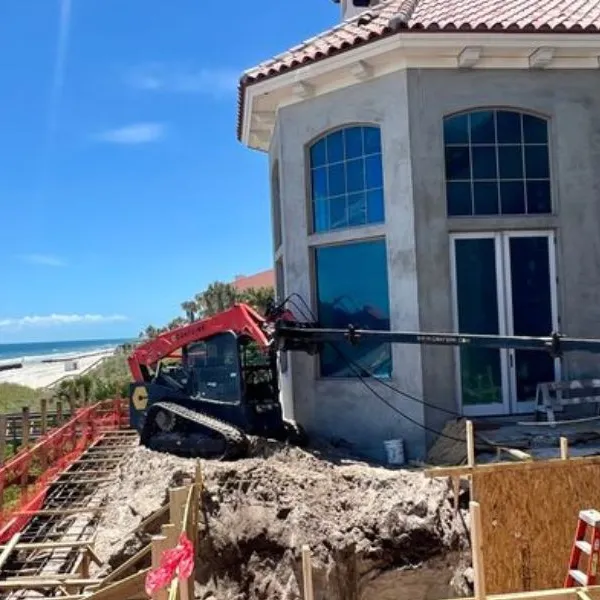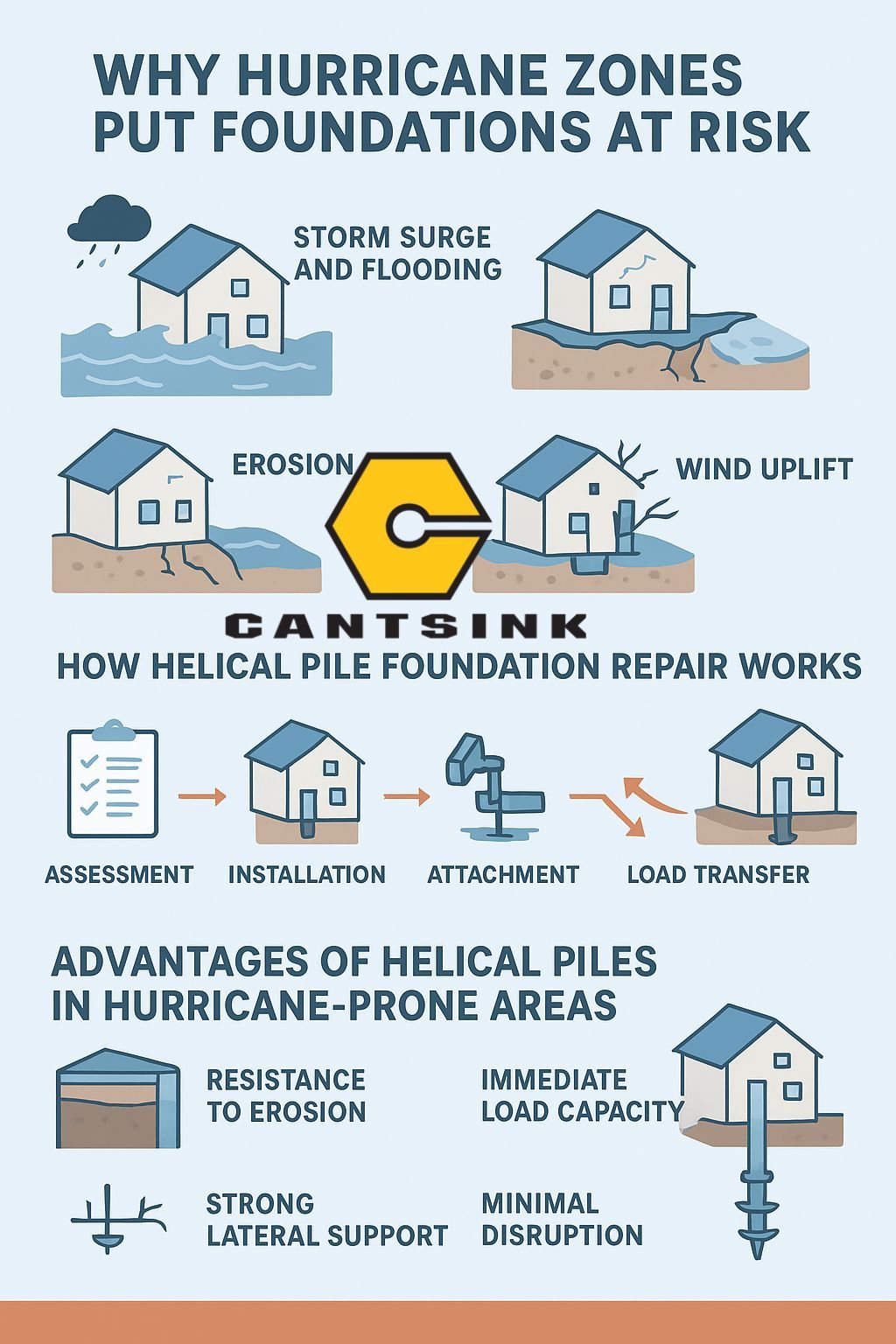
Living in a hurricane-prone region brings unique challenges for homeowners, builders, and property managers. Strong winds, storm surge, and flooding can weaken or even destroy foundations if they're not designed to withstand these extreme conditions. In high-risk coastal zones, where soil erosion and water saturation are common, foundation stability is one of the most critical elements of protecting your property. That's why helical pile foundation repair has become an essential solution in areas vulnerable to hurricanes. Unlike traditional repair methods, helical piles provide unmatched stability, adaptability, and resilience in the types of soils most affected by storms. This blog will explore why foundations fail in hurricane zones, how helical piles work, and why they're the smart choice for storm-resistant foundation repair and construction.
Why Hurricane Zones Put Foundations at Risk
When hurricanes strike, foundations face multiple threats. These include:
Storm Surge and Flooding: Rising water levels wash away soil, creating voids under foundations.
Erosion: Waves and floodwaters can strip away supporting soil layers.
Saturated Soil: Excess moisture causes soil to lose strength and shift beneath heavy structures.
Wind Uplift: Strong winds can create lateral and upward forces that stress foundations.
Debris Impact: Floating objects or collapsing structures may add sudden loads to weakened foundations.
Homes and businesses in hurricane zones are particularly vulnerable if they were built on shallow foundations, sandy soils, or areas where water tables are high. Over time, even structures that have withstood multiple storms may begin to show signs of settlement and damage.
Warning Signs of Foundation Damage After a Hurricane
After a severe storm, property owners should carefully inspect their foundations. Some red flags that may indicate the need for helical pile foundation repair include:
Cracks in walls, ceilings, or slabs
Doors and windows that no longer close properly
Tilting or leaning of chimneys, porches, or decks
Noticeable sinking or uneven flooring
Gaps forming between walls and baseboards
Shifting or separation in exterior brickwork or siding
Addressing these signs early can prevent further damage and help stabilize the structure before the next storm season.
What Are Helical Piles?
Helical piles (also called helical piers or screw piles) are deep foundation elements made of steel shafts with helical plates welded to them. Think of them like giant screws that are twisted into the ground until they reach a stable soil layer.
Once installed, they act as anchors that secure the structure, transferring loads away from weak surface soils to more reliable layers deeper underground. In hurricane-prone regions, this technology is especially valuable because it resists both vertical settlement and lateral forces caused by wind and water.
How Helical Pile Foundation Repair Works
The process of foundation repair with helical piles in hurricane zones is straightforward but highly effective:
Assessment: Engineers and foundation specialists evaluate soil conditions, storm damage, and structural needs.
Installation: Using hydraulic equipment, helical piles are screwed into the ground until they reach stable strata.
Attachment: Brackets are connected to the existing foundation or new structure.
Load Transfer: The weight of the building is shifted from unstable soils to the helical piles.
Stabilization or Lift: In damaged structures, piles can also help lift the foundation back toward its original level.
This process is minimally invasive, requires no large-scale excavation, and can often be completed more quickly than other foundation methods.

Advantages of Helical Piles in Hurricane-Prone Areas
When compared to traditional foundation systems, helical piles offer several advantages that make them the best choice for hurricane zones:
1. Resistance to Erosion
Helical piles extend deep below the surface into stable soil layers, bypassing loose or eroded soils. This makes them far less vulnerable to storm surge and washouts.
2. Immediate Load Capacity
Unlike poured concrete piers, which require curing, helical piles are load-ready immediately after installation—an important factor in urgent repair situations after a storm.
3. Strong Lateral Support
Their design resists both vertical settlement and horizontal forces caused by wind and water pressure.
4. Minimal Disruption
Helical piles can be installed quickly, even in areas with limited access or standing water, reducing disruption to homeowners and businesses.
5. Long-Term Stability
With proper installation, helical piles provide decades of foundation stability, making them a long-term investment in hurricane preparedness.
Residential Applications in Hurricane Zones
For homeowners, helical pile foundation repair can mean the difference between costly structural collapse and long-term safety. Common applications include:
Stabilizing homes built on sandy or erodible soils
Repairing foundations damaged by flooding or storm surge
Supporting elevated homes built on pilings
Reinforcing decks, porches, and outdoor structures exposed to high winds
Protecting retaining walls and seawalls from erosion
Because helical piles can be installed in tight spaces with minimal excavation, they're ideal for residential neighborhoods where damage may be widespread after a storm.
Commercial and Infrastructure Applications
Beyond homes, hurricane-prone regions often rely on helical piles for commercial and infrastructure projects. Examples include:
Coastal office buildings and warehouses
Elevated boardwalks and piers
Solar farms in coastal regions
Communication towers
Bridge abutments and walkways
Pipeline and utility supports
These applications highlight the versatility and strength of helical piles in protecting essential infrastructure from storm damage.
Comparing Helical Piles to Other Foundation Methods
In hurricane zones, property owners and contractors may consider several foundation repair methods. Here's how helical piles measure up:
Concrete Piers: Vulnerable to washout, require long curing times, and don't perform well in water-saturated soils.
Timber Piles: Common in older coastal construction but prone to rot and deterioration over time.
Slabjacking: Fills voids under concrete but doesn't address deep soil instability.
In comparison, helical pile foundation repair provides a faster, more durable, and more storm-resistant solution for properties in high-risk areas.
Building Stronger From the Start
Helical piles aren't just for repairs—they're also an excellent choice for new construction in hurricane zones. By installing piles deep into stable soil layers, builders can create elevated structures that resist both flooding and wind damage. This proactive approach saves property owners significant money and stress by preventing foundation issues before they occur.
Why Choose Cantsink for Hurricane Zone Foundation Repair?
Cantsink has decades of experience manufacturing and installing ICC-ES certified helical piles across hurricane-prone regions in the Southeast. Our reputation for quality, reliability, and engineering precision makes us a trusted partner for both homeowners and contractors.
When you work with Cantsink, you get:
Certified Manufacturing: Every helical pile is engineered to meet rigorous industry standards.
Expert Installation: Our teams use advanced equipment to ensure precise and effective repairs.
Customized Solutions: No two properties are alike—we design foundation strategies for your unique soil and structural needs.
Proven Track Record: Thousands of successful projects across Georgia, Florida, and beyond.
Our Foundation Repair Process
At Cantsink, we follow a proven process to protect your home or business in hurricane-prone areas:
Inspection & Evaluation - Our experts identify foundation damage and analyze soil conditions.
Custom Plan - We develop a tailored repair strategy using the right number and placement of piles.
Installation - Helical piles are screwed deep into stable strata for maximum support.
Stabilization - Foundations are lifted, leveled, or stabilized to prevent further damage.
Long-Term Support - We stand behind our work and provide ongoing guidance for storm readiness.
Protecting Your Property Investment
Hurricanes will always be a threat in coastal regions, but foundation failure doesn't have to be. With helical pile foundation repair, property owners can safeguard their investments, protect their families, and ensure their structures are resilient against future storms.
In high-risk hurricane zones, foundation strength is not optional—it's essential. Helical piles provide the deep stability, storm resistance, and long-term reliability that traditional foundation methods can't match. Whether you're repairing hurricane damage or building new in a coastal area, helical pile foundation repair offers the peace of mind that your property is secure.
At Cantsink, we're proud to help homeowners, businesses, and communities build stronger, safer foundations. Contact us today to schedule an inspection and learn how our helical pile systems can protect your property from the next storm.